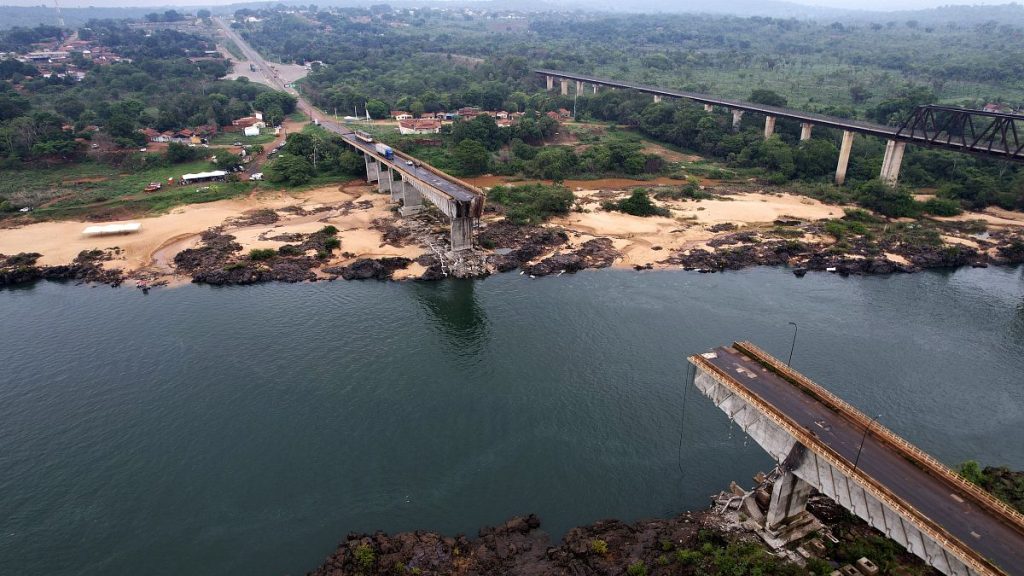The Juscelino Kubitschek de Oliveira Bridge, a vital transportation artery connecting the northern Brazilian states of Maranhão and Tocantins, met a catastrophic fate on December 24th when a section crumbled, sending vehicles plummeting into the Tocantins River below. This devastating incident has claimed the lives of nine individuals, with the somber discovery of a woman’s body six kilometers downstream adding to the mounting toll. Eight more individuals remain missing, leaving families and communities grappling with uncertainty and grief as search and rescue operations continue. The bridge, spanning 533 meters and linking the cities of Estreito and Aguiarnópolis, served as a crucial link for commerce and travel in the region. Its collapse has disrupted transportation networks and left a void in the infrastructure of northern Brazil.
The collapse of the Juscelino Kubitschek de Oliveira Bridge has not only resulted in a tragic loss of life but also poses significant questions about the structural integrity of Brazil’s aging infrastructure. Built in the 1960s, the bridge had served the region for over half a century, raising concerns about the potential for similar incidents across the country. While the exact cause of the collapse remains undetermined, investigations are underway to ascertain the factors that contributed to this disaster. The incident underscores the critical need for regular inspections, maintenance, and upgrades to ensure the safety and reliability of bridges and other vital infrastructure, particularly those built decades ago.
The immediate aftermath of the bridge collapse witnessed a frantic scramble for survivors as rescue teams, including the Brazilian Navy, combed the Tocantins River and its banks. The recovery of vehicles – four trucks, two cars, and two motorcycles – paints a grim picture of the chaos that ensued as the bridge gave way. The search for missing individuals continues, though hopes dwindle with each passing day. The incident has left a deep scar on the communities connected by the bridge, highlighting the human cost of infrastructure failures and the importance of investing in robust and resilient infrastructure.
The Juscelino Kubitschek de Oliveira Bridge disaster serves as a stark reminder of the vulnerability of infrastructure and the potential for catastrophic consequences when structural integrity is compromised. The incident highlights the need for proactive measures to prevent similar tragedies in the future. This includes not only regular inspections and maintenance but also a comprehensive assessment of aging infrastructure to identify potential weaknesses and implement necessary upgrades. Investing in resilient infrastructure is not merely a matter of economic development; it is a crucial investment in public safety and the well-being of communities.
The investigation into the bridge collapse will likely focus on several key areas, including the age of the structure, maintenance records, and any potential signs of deterioration that may have been overlooked. Experts will analyze the materials used in the bridge’s construction, assess the impact of environmental factors like weather and erosion, and examine the design and engineering of the bridge itself. The findings of this investigation will be crucial in determining the root cause of the collapse and informing strategies to prevent similar incidents in the future. The investigation’s outcome will also likely play a significant role in any legal proceedings that may arise from the tragedy.
Beyond the immediate investigation, the collapse of the Juscelino Kubitschek de Oliveira Bridge underscores the broader need for a national strategy to address the challenges of aging infrastructure in Brazil. This requires a significant commitment of resources to inspect, maintain, and upgrade existing infrastructure, as well as to develop new, more resilient infrastructure projects. Furthermore, it necessitates a shift towards preventative maintenance, prioritizing regular inspections and proactive repairs to prevent catastrophic failures rather than reacting to them after they occur. The tragedy serves as a wake-up call, emphasizing the importance of investing in safe and reliable infrastructure to protect lives, support economic growth, and ensure the well-being of communities across the country.














